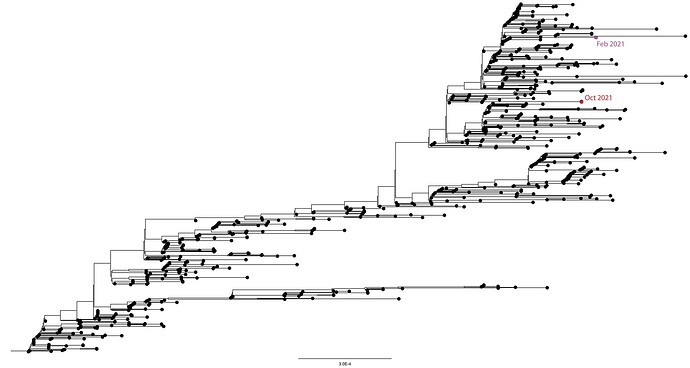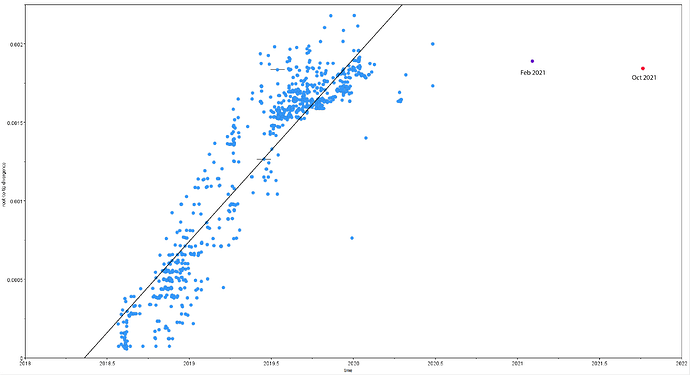The new case of Ebola Virus Disease in Beni is linked to the 2018-2020 Nord Kivu/Ituri EVD outbreak and does not represent a new spillover event.
Context
On October 08, 2021, a case of Ebola virus disease (EVD) was confirmed in a 29-month-old male child, living in Butsili health area in the Beni health zone, province of Nord Kivu in the Democratic Republic of Congo. The patient was treated successively in three health facilities in the Beni health zone since September 27, 2021 and died on October 6, 2021 in a local health facility with haemorrhagic clinical signs. A swab was taken on October 07, 2021 by staff from the health facility where the patient died and was sent to the National Institute for Biomedical Research (INRB) Rodolphe Mérieux laboratory in Goma. The sample tested positive for Ebola virus using the GeneXpert Xpert Ebola Assay (Cepheid, Sunnyvale, CA) on October 08.
This case follows a cluster of three suspected EVD deaths reported by the Beni health zone officials on September 30 that occurred within a household in Butsili health area on September 14, 19 and 29, 2021. The three suspected EVD cases lived in the same neighborhood as the confirmed case. Samples were not collected from these cases and safe and dignified burials were not performed.
Beni health zone was one of the epicenters of the 2018-2020 Nord Kivu/Ituri outbreak. It is also close to the four health zones which experienced a flare-up of cases between February 7 and May 3, 2021, which was linked to a persistent source from the 2018-2020 outbreak. These new cases are occurring in an area with complex security and humanitarian issues, making epidemiological investigations challenging. Positive samples were sent to the INRB Pathogen Genomics Sequencing laboratory in Kinshasa to generate whole viral genomes to support the ongoing epidemiological investigation.
Sequencing
The swab sample, 21-BEN114, was sequenced at the Pathogen Genomics Sequencing laboratory using both Illumina and Oxford Nanopore Technologies (ONT) platforms. Sequencing libraries were prepared using an amplicon sequencing approach (Mbala-Kingebeni, 2021; Grubaugh et al., 2019; Quick et al. 2017), generating identical genomes with 99.5% and 96.7% genome coverage for Illumina and ONT, respectively.
The new genome was aligned with all genomes from the 2018-2020 Nord Kivu/Ituri outbreak and the February-May 2021 resurgence with over 95% coverage using MAFFT (Katoh, 2013). A phylogenetic tree was inferred using IQTREE (Nguyen et al., 2015; Figure 1) indicating that the new genome was most closely related to genomes sampled around July 2019, from the 2018-2020 Nord Kivu EVD outbreak. This case represents a new flare-up event from the 2018-2020 outbreak, and is not linked to the February 2021 flare-up, nor a new spillover event.
Figure 1 | Maximum likelihood phylogenetic tree of 2018-2021 Nord Kivu/Ituri EVD outbreak genomes. Genomes from the February-May 2021 EVD outbreak and sample 21-BEN114 from the October 2021 outbreak are indicated. Phylogenetic tree inferred using IQTREE under the GTR+G substitution model.
When reviewing the alignment of 21-BEN114 with all previously sequenced Nord Kivu genomes, 21-BEN114 has 11 mutations. Three of these are shared with all other genomes in the top half of the tree. Two mutations are shared uniquely with a single deceased individual that was sampled in July 2019. Six of the mutations are unique to 21-BEN114. Therefore, 21-BEN114 is six mutations diverged from the closest genome, which was collected in July 2019. Six mutations over a period of approximately 812 days is an estimated rate of 1.42x10-4 substitutions per site per year. The rate for the entire outbreak has been calculated to be 8x10-4(Mbala-Kingebeni, 2021), therefore there is a 5.6-fold reduction in the evolutionary rate along the branch to 21-BEN114, indicative of infection from a persistent source. This is further evidenced in the root-to-tip plot (Figure 2) where the new case is an outlier, indicative of a slowed evolutionary rate.
Figure 2 | Root-to-tip plot . Plot of genetic divergence from the root of the phylogenetic tree against the time of sampling for genomes from the 2018-2021 EVD outbreak in Nord Kivu/Ituri. Resurgences in Feb 2021 and October 2021 are indicated.
In conclusion, our initial findings indicate that the October 2021 EVD outbreak likely represents a new flare-up of the 2018-2020 Nord Kivu/Ituri EVD outbreak, initiated by transmission of EBOV from a persistently infected survivor or a survivor who experienced relapse. Epidemiologic investigations are ongoing to determine the source.
Data availability
The genome sequence and figures are available here.
Partners and collaborators
Placide Mbala-Kingebeni (INRB, University of Kinshasa)
Jean-Jacques Muyembe (INRB, University of Kinshasa)
Steve Ahuka-Mundeke (INRB, University of Kinshasa)
Hugo Kavunga (INRB)
Daniel Mukadi (INRB, University of Kinshasa)
Elisabeth Pukuta (INRB)
Eddy Kinganda Lusamaki (INRB, University of Kinshasa)
Amuri Aziza (INRB, University of Kinshasa)
Jean Claude Makangara (INRB, University of Kinshasa)
Emmanuel Lokilo (INRB)
Franck Edidi (INRB, University of Kinshasa)
Junior Bula Bula (INRB, University of Kinshasa)
John Otshudiema (WHO)
Raphael Lumembe (INRB, University of Kinshasa)
Gabriel Kabamba (INRB, University of Kinshasa)
Mike Wiley (University of Nebraska Medical Center [UNMC], PraesensBIO)
Catherine Pratt (UNMC)
Statement on continuing work and analyses prior to publication
This genome is being shared pre-publication. Please note that this data is based on work in progress and should be considered preliminary. Our analyses of these data are ongoing and a publication communicating our findings on these and other published genomes is in preparation. If you intend to use these sequences prior to our publication, please communicate with Dr. Placide Mbala for coordination.
References
Grubaugh ND, Gangavarapu K, Quick J, et al. An amplicon-based sequencing framework for accurately measuring intrahost virus diversity using PrimalSeq and iVar. Genome Biol 2019;20:8. 10.1186/s13059-018-1618-7 4
Katoh K, Standley DM. MAFFT multiple sequence alignment software version 7: improvements in performance and usability. Mol Biol Evol 2013;30:772-80. 10.1093/molbev/mst010
Mbala-Kingebeni P, Pratt C, Mutafali-Ruffin M, et al. Ebola Virus Transmission Initiated by Relapse of Systemic Ebola Virus Disease. N Engl J Med 2021; 384:1240-1247 10.1056/NEJMoa2024670
Nguyen LT, Schmidt HA, Haeseler A, and Minh BQ. IQ-TREE: A fast and effective stochastic algorithm for estimating maximum likelihood phylogenies. Mol. Biol. Evol. 2015, 32:268-274. 10.1093/molbev/msu300
Quick, J., Grubaugh, N., Pullan, S. et al. Multiplex PCR method for MinION and Illumina sequencing of Zika and other virus genomes directly from clinical samples. Nat Protoc 2017;12:1261–1276. 10.1038/nprot.2017.066 2

